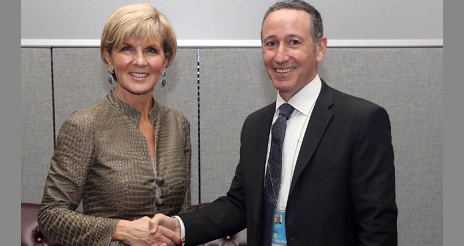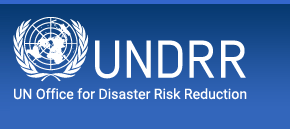- Our Mandate
- Mission and Objectives
- UNDRR in the UN
- Work Programme & Annual Reports
- Results Based System
- Work Partnerships
- Headquarters - Geneva
- SG-UN representatives for DRR
- Regional Office – The Americas and the Caribbean
- Head of the Regional Office – The Americas and the Caribbean
- What is Disaster Risk Reduction?
- What is the International Strategy?
- History of UNDRR
UN Summit: Disasters contribute to migrant crisis
 Mr. Robert Glasser, the UN Secretary-General's Special Representative for Disaster Risk Reduction (right) met with Ms. Julie Bishop, Australian Minister for Foreign Affairs, on the sidelines of the UN Summit on Refugees and Migrants
Mr. Robert Glasser, the UN Secretary-General's Special Representative for Disaster Risk Reduction (right) met with Ms. Julie Bishop, Australian Minister for Foreign Affairs, on the sidelines of the UN Summit on Refugees and Migrants
By: UNDRR
NEW YORK, 20 September 2016 – Governments at the UN Summit on Refugees and Migrants have adopted a landmark declaration that underlines the role of environmental degradation, climate change and disasters alongside conflict as drivers of the ongoing crisis.
The "New York Declaration" contains ambitious commitments to find durable solutions and coordinated approaches, to address root causes and to provide a more humane and managed response to the plight of refugees and migrants.
Opening the summit, Mr. Peter Thomson, the senior Fijian diplomat who is President of the 71st Session of the UN General Assembly, highlighted the brutal consequences of war, gross human rights abuses, and the adverse effects of climate change and disasters as some of the sparks that started the worst refugee crisis since the Second World War.
Globally, more than 60 million people are now displaced by conflict, violence, disasters and human rights violations.
The summit was an opportunity to reflect on the shortcomings of the status quo. Mr. Zeid Ra'ad Zeid Al-Hussein, United Nations High Commissioner for Human Rights, urged governments to change course and work together to ensure millions of refugees and migrants are treated with dignity and respect.
The principle focus of the UN Summit on Refugees and Migrants was the suffering endured by those who are forced from their homes by conflict. Nonetheless, there is a growing problem of displacement which is not conflict-related but which can in turn contribute to societal tensions which lead to conflict.
"A record number of people are uprooted and forced to move – refugees, internally displaced persons, victims of trafficking, unaccompanied minors. Climate change threatens yet a further 75 million living just one meter above sea level," said Mr. William Lacy Swing, Director of the International Organization for Migration, which this week officially become a UN-related body.
Migration should be an active choice for a better life and not a last resort, said summit participants. But more people than ever are driven from their homes in search of safety rather than in search of opportunity.
"Intensified by unplanned urbanisation, environmental degradation and climate change, natural hazards are a driving force behind large movements of migration," said Mr. Robert Glasser, the UN Secretary-General's Special Representative for Disaster Risk Reduction. "Migration, both internal and international, is for many who are exposed and vulnerable, the only viable option."
Internal displacement is a good barometer of humanitarian needs around the globe. Last year 19.2 million people were displaced by natural hazards in 113 countries.
Displacement is often an indication of the breakdown of normal coping strategies when resilience is undermined by a severe disaster event.
Almost three million people remain in temporary accommodation in Nepal, more than a year after an earthquake which killed over 8,000 people in a country still recovering from years of conflict.
People are on the move across southern Africa as a result of a prolonged agricultural drought in a region where the resources for conserving water, and thereby reducing disaster risk, are very limited.
The majority of displacement by natural hazards in 2015 was caused by extreme weather events due to a record number of droughts, widespread flooding and 90 major tropical storms. Much of this was fuelled by a very strong El Niño occurring in the context of climate change.
Ms. Mary Robinson, Special Envoy of the UN Secretary-General on El Niño and Climate, underscored that we live in a "new and not comfortable normal" due to the increasing pace of climate change and growing severity of disasters. Prevention is possible, and by listening to those who have already been affected or displaced we can develop coping strategies so people can build better lives at home, she added.
Engaging those affected by disasters, including migrants, in the design and implementation of disaster risk reduction plans is a tenet of the Sendai Framework for Disaster Risk Reduction, a wide-ranging agreement adopted by the international community in March 2015.
The Sendai Framework also promotes more dedicated action to tackle underlying disaster risk drivers, such as poverty and inequality. "In order to address the drivers of migration we can start with reducing the risks", said Mr. Glasser.
Follow the UNDRR news online:
 Now we have twitter account @UNDRR Américas y el Caribe
Now we have twitter account @UNDRR Américas y el Caribe
JOIN US!
Tweets por el @UNDRR Américas y el Caribe
